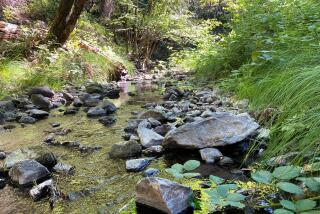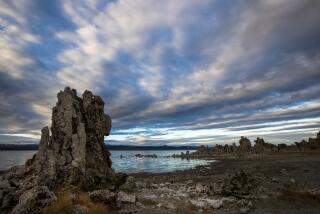Stream Is Now Bed of Controversy : Water: Verdugo Woodlands residents blame the city’s wells for the drying up of the scenic creek. Officials cite the drought and sewers.
- Share via
Most longtime residents of the Verdugo Woodlands recall the story about the ducks that populated a picturesque stream that flowed through a pristine Glendale neighborhood.
One day about 12 years or so ago, the ducks emerged from their nest in the ivy of one front yard to waddle across the street to the stream, in another front yard. Trailing behind them was a precision row of ducklings.
“They marched across the street right in front of the dogcatcher, who had to stop and wait for them,” said Lorene Simon, whose family had brought the ducks to the stream in their yard. The animal control officer deemed the web-footed creatures a traffic hazard and promptly issued the family a citation.
The Simons fought the ticket. A sympathetic judge, swayed by the outraged protests of neighbors and friends of the ducks, ordered the city, instead, to install a “Duck Crossing” sign, thus officially authorizing fowl play in Glendale.
Residents now suspect a different kind of foul play has befallen their stream, which ran through private yards along Niodrara Drive from Wabasso Way to Verdugo Park before it went dry in 1986. They blame the city’s increased pumping of water wells about a mile north of the defunct stream, which they say has reduced the ground water and cut off the artesian flow.
But city officials blame the drop in ground water on the drought and on the installation of sewers in La Crescenta and La Canada Flintridge, where septic systems had returned water into the ground.
A controversial proposal to dig seven wells and pump water out of Verdugo Park was dropped in 1984 after residents complained that the plan would jeopardize the stream and about 300 aged sycamore and oak trees in the park.
Now, after five years of drought and with a possible sixth year of critical water shortages ahead, Glendale has revived the plan to pump water from the park, only this time with two wells far away from trees.
To further appease residents, the city proposes to restore the stream by pumping some of the water back through the Niodrara neighborhood and into the park riverbed, called the West Side Stream.
Some residents welcome the idea. Others are skeptical that pumping water from the park will not endanger trees, although an environmental study released this month concludes otherwise.
Residents have until March 21 to comment on the report, which can be viewed on the sixth floor of the Public Service building or in the city Planning Department. Public hearings are expected to be set in late March or early April before the Environmental and Planning Board and the City Council.
After a 20-year court battle between local jurisdictions and the city of Los Angeles over water rights, Glendale in 1979 was given permission to pump 3,800 acre-feet of water a year from the Verdugo basin.
The city now pumps about 2,000 acre-feet of water from wells north of the park, said Donald R. Froelich, city water services administrator. Additional wells in the park would allow the city to capture another 1,800 acre-feet of water--enough to supply 3,600 households, or about 9,000 residents, Froelich said.
The city can pump and treat local water for about $100 an acre-foot, far cheaper than the $230-per-acre-foot cost of buying imported water from the Metropolitan Water District, Froelich said. The system could be in operation by the end of this year, when further cutbacks in water supplies are projected by the MWD if the drought continues.
Historically, rainwater that falls in the San Gabriel foothills in north Glendale flows into the underground basin through the Verdugo Narrows in two main channels: the West Side Stream, which surfaced along Niodrara Drive, and the East Side Stream, now the Arroyo Verdugo flood control channel.
The water runs both on the surface and underground, depending on the amount of rainfall. In the early years, water from the streams collected at Verdugo Park, which was then a swamp, where it seeped into the ground.
Local engineers tapped into the natural water supply for an irrigation system in Glendale as long ago as 1898, according to historical reports. The city was deeded the water supply in 1919 by F.P. Newport.
An underground dam and shallow pickup system were built in the Verdugo basin and used to supply a regular water source to the city from 1922 until 1978, when the state health department ordered the city to stop using the shallow supply because of the potential for contamination from the surface.
That water--about 1,000 acre-feet a year worth more than $200,000--has been going to waste during years of high ground-water levels, dumped into the Arroyo Verdugo flood control channel. There is no wasted runoff in the basin now, because of the low water level resulting from the drought, Froelich said.
The new proposal calls for digging wells 100 feet deep or more to tap into water that has been naturally purified through percolation. The city also plans to build a treatment plant at the park to meet state water-quality standards.
The environmental study recommends that water be pumped up to the head of the surface stream near Colina Drive, then allowed to flow back through the neighborhood into the park, where it would seep into the ground again for reuse.
When the neighborhood stream along Niodrara dried up, it left behind a curious landscaping of blue-painted creek channels filled only with overgrown ivy and fallen leaves. Elaborate water wheels, dry lily and duck ponds, footbridges and waterfalls mark the path where it once flowed.
Simon said the stream was an important asset to property values. “We bought and paid for this lovely stream and we feel like its drying up has devaluated our property,” she said.
The Simons had previously lived for 17 years in the Verdugo Woodlands area and frequently drove through the Niodrara Drive area to admire the stream. When their dream house went up for sale, Simon’s husband was the first to spot the sign and immediately negotiated the purchase. That was 27 years ago.
Simon said she remembers the stream as “clear and clean and cold. We had crawdads, ducks and geese. It was a beautiful, pristine place.”
More to Read
Sign up for Essential California
The most important California stories and recommendations in your inbox every morning.
You may occasionally receive promotional content from the Los Angeles Times.










